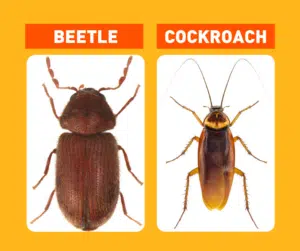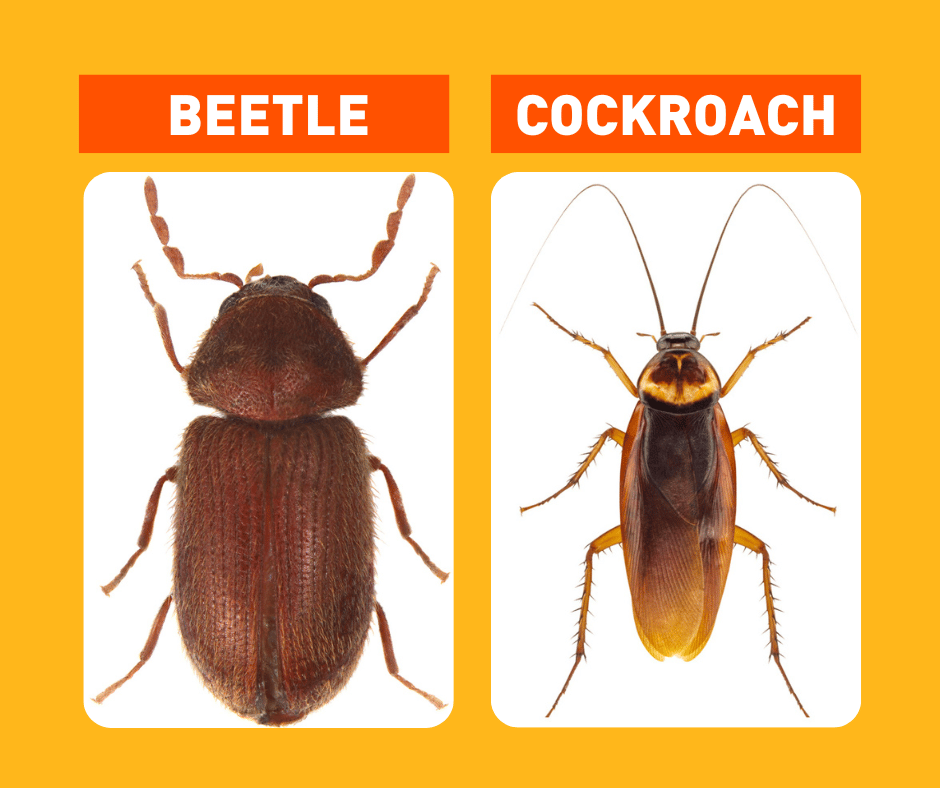Cockroaches have long antennae that constantly move, while beetles have shorter, less mobile antennae. When it comes to identifying cockroaches and beetles, it’s essential to distinguish their physical characteristics.
Cockroaches are known for their long, constantly moving antennae, while beetles have shorter, less mobile antennae. Additionally, cockroaches generally have an oval and flattened body shape, while beetles tend to be thicker and rounder. These distinctions can be crucial in differentiating between the two insects, especially in the context of pest control and identification.
Understanding the unique traits of cockroaches and beetles is essential for effective management and prevention of infestations. By recognizing these differences, individuals can better protect their homes and environments from potential pest-related issues.
Physical Characteristics
When distinguishing between a cockroach and a beetle, focus on their antenna length. Beetles have shorter, stationary antennas, while cockroaches boast long, constantly moving ones. This key difference aids in quickly identifying these distinct insect species.
Physical Characteristics:When it comes to identifying insects, it’s crucial to understand their physical characteristics. In this section, we will compare cockroaches and beetles based on their antenna length, body shape, and size.Antenna Length:Looking at the antenna length is the easiest way to tell a cockroach from a beetle. Beetles have short antennae that don’t move much, while cockroaches have long antennae that are constantly moving and twitching.Body Shape and Size:Cockroaches have a distinctive oval-shaped body that is wider than a beetle’s. They can grow up to 1.5 inches long, and their body is flat and streamlined, allowing them to squeeze into tight spaces. Beetles, on the other hand, have a harder exoskeleton and a more rounded body shape. They can be as small as a few millimeters or as large as a few inches.In Conclusion:In conclusion, when it comes to identifying insects, understanding their physical characteristics is crucial. By looking at their antenna length, body shape, and size, you can easily tell a cockroach from a beetle. Knowing the difference between these two pests can help you identify and control an infestation quickly.
Credit: bugguide.net
Behavioral Traits
When it comes to behavioral traits, understanding the movement patterns and activity time of cockroaches and beetles can provide insight into their habits and preferences.
Movement Patterns
Cockroaches are known for their fast and erratic movement patterns. They are adept at scurrying and can navigate through tight spaces with ease. On the other hand, beetles exhibit a more deliberate and steady movement, often using their wings for flight when necessary.
Activity Time
Cockroaches are predominantly nocturnal, preferring to be active during the night when they scavenge for food and water. In contrast, beetles are active during both day and night, with some species being diurnal while others are nocturnal.
Habitat And Environment
Understanding the habitat and environment of cockroaches and beetles is essential for effective pest control and overall knowledge of these insects. Both creatures have distinct preferences when it comes to their living conditions and geographical distribution.
Preferred Living Conditions
Cockroaches are highly adaptable and can thrive in various environments. They prefer warm and humid areas, such as kitchens, bathrooms, and basements. Dark, moist, and cramped spaces are ideal for cockroaches to breed and multiply, making households and commercial buildings their prime habitats.
On the other hand, beetles are diverse in their living conditions. They can be found in forests, fields, gardens, and even urban areas. Many beetle species feed on decaying matter, while others prey on plants and crops, showcasing their versatility in different ecological niches.
Geographical Distribution
Cockroaches are prevalent in tropical and subtropical regions, thriving in areas with high temperatures and humidity. They are commonly found in southern states of the United States and various parts of the world with similar climates.
Beetles, on the other hand, have a widespread distribution, inhabiting almost every terrestrial habitat on Earth. From rainforests to deserts, and from mountainous regions to coastal plains, beetles have established their presence across the globe, showcasing their adaptability and resilience.
Diet And Feeding Habits
Cockroaches and beetles have different diet and feeding habits. Cockroaches have long antennae and are constantly moving to search for food and water, while beetles have shorter antennae and move less. Cockroaches have an oval and flattened body shape, while beetles lean toward the thicker, rounder side.
When it comes to identifying different insect species, one of the key factors to consider is their diet and feeding habits. This is particularly relevant when comparing cockroaches and beetles. Let’s take a closer look at the food preferences and feeding behaviors of these two types of insects.Food Preferences
Cockroaches are known for being scavengers, which means they will eat just about anything they can find. This includes food scraps, decaying organic matter, and even other insects. They are also attracted to sweet and starchy foods, which is why they are commonly found in kitchens and pantries. On the other hand, beetles have a more varied diet that can include plants, fungi, and even other insects. Some beetle species are also known to feed on decaying matter, while others are predators that hunt for their food.Feeding Behaviors
Cockroaches are primarily nocturnal insects, which means they are most active at night. They are also known for their ability to survive for long periods of time without food or water. When they do find a food source, they will often regurgitate and re-consume their food to extract as many nutrients as possible. Beetles, on the other hand, are active during the day and tend to feed more regularly. Some beetle species are known for their ability to emit noxious chemicals as a defense mechanism against predators.In conclusion, while both cockroaches and beetles are known for their scavenging tendencies, they have distinct food preferences and feeding behaviors. Cockroaches are opportunistic feeders that will consume almost anything they can find, while beetles have a more varied diet that can include plants and other insects. Understanding these differences can be helpful when it comes to identifying and controlling pest infestations.Potential Risks
When dealing with cockroaches and beetles, it’s crucial to understand the potential risks associated with these pests. Both can pose significant threats to health and property, making it essential to be aware of the potential dangers they bring.
Health Concerns
Cockroaches and beetles can both trigger allergies and asthma in individuals, especially in children. Their presence can exacerbate respiratory conditions, leading to health complications.
- Cockroaches and beetles can spread disease-causing bacteria and pathogens.
- They can contaminate food and surfaces, posing a risk of food poisoning and infections.
- Cockroach droppings and beetle infestations can contribute to indoor air pollution, affecting overall indoor air quality.
Property Damage
Both cockroaches and beetles can cause significant property damage, which may lead to costly repairs and structural issues.
- Cockroaches can damage household items, such as books, fabrics, and paper.
- Beetles are known to infest and damage wooden structures and furniture, posing a threat to the integrity of buildings.
- Both pests can tarnish the aesthetic appeal of homes and businesses, leading to devaluation of properties.
Identification Challenges
When distinguishing between cockroaches and beetles, identifying them correctly can be a challenge due to their similar appearances.
Similarities
- Cockroaches and beetles can both have an oval-shaped body, making it confusing to differentiate them at first glance.
- Both insects can vary in size and color, further complicating the identification process.
- Roaches and beetles may be found in similar environments, adding to the difficulty of proper identification.
Common Misidentifications
- Oriental beetles are often mistaken for cockroaches due to their light brown coloring and similar body shape.
- June bugs or May beetles, with their reddish-brown to black coloration, can also be misidentified as roaches.
- People sometimes confuse cockroaches with other beetles due to their overlapping physical characteristics.
Effective Control Methods
When dealing with pest infestations, understanding the differences between cockroaches and beetles is crucial. Effective control methods tailored to each species can help prevent and eliminate these unwanted intruders.
Preventive Measures
- Keep food sealed: Store food in airtight containers to deter pests.
- Maintain cleanliness: Regularly clean and declutter to remove potential hiding spots.
- Seal entry points: Use caulk or weather stripping to seal cracks and crevices.
Professional Intervention
For severe infestations or if preventive measures are ineffective, seeking professional pest control services is recommended. Professionals can accurately identify the pest species and implement targeted treatment plans for effective eradication.

Credit: www.earthkind.com

Credit: www.reddit.com
Frequently Asked Questions
How To Tell If It’s A Cockroach Or A Beetle?
To distinguish between a cockroach and a beetle, observe their antennae. Beetles have shorter, motionless antennae, while cockroaches have long, constantly moving antennae. This key difference sets them apart.
Can Beetles Be Mistaken For Roaches?
Beetles can be mistaken for roaches, especially oriental beetles with similar coloring and shape.
How To Tell If It’s A Cockroach?
To identify a cockroach, look at its long, constantly moving antennae, often the same length as its body. Cockroach antennae are longer and more active compared to beetles.
Conclusion
Distinguishing between a cockroach and a beetle can be based on antenna length. Cockroaches have long, constantly moving antennae, while beetles have shorter, stationary antennae. Understanding these key differences can help in identifying and dealing with these pests effectively.
Related posts:

I’m MD Tanvir, and I bring years of expertise gained from working closely with pest control companies to the forefront. My journey in the industry has inspired me to launch Bug Battler, a platform aimed at equipping people with the know-how to combat pests autonomously. Through Bug Battler, I aim to empower individuals with practical insights to tackle pest infestations effectively.

